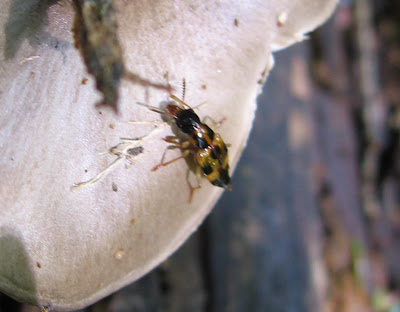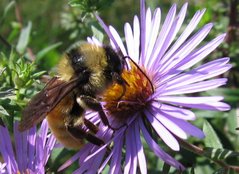
Thursday, January 11, 2007
Sunday, January 07, 2007
Saturday, January 06, 2007
Entoloma

 Entoloma
EntolomaAlgonquin Provincial Park, Bat Lake
25 June 2006
Entoloma are very difficult to identify to species. The stain on the gills is indicative of the pink spore colour indicative of Entoloma. It looks something like Entoloma clypeatum in George Barron's "Mushrooms of Ontario and Eastern Canada," but it would only be guessing to label it as this species. For a description of the Rove Beetle in this picture, see under insects.
Fungus Rove Beetle



 Oxyporus quinquemaculatus
Oxyporus quinquemaculatusAlgonquin Provincial Park (Bat Lake)
25 June, 2006
These beetles are from the family Staphylinidae (Rove Beetles), subfamily Oxyporinae, genus Oxyporus. Stephen Marshall indicates that the family Staphylinidae "constitutes one of the last great frontiers in North American beetle taxonomy." Staphylinidae is the largest family of beetles in North America and it is possible that less than half of the species have been identified yet. Marshall says that "Rove beetles are usually predacious, but some feed on fungal spores or tissue..." If you look at the first picture, above, you can see that these beetles have been doing a pretty good job of eating this Entoloma fungus.
Friday, January 05, 2007
Forked Fungus Beetle

 Bolitotherus cornutus
Bolitotherus cornutusBat Lake, Algonquin Provincial Park
June 25, 2006
(Found on Shelf Fungus, Fomitopsis pinicola)
The Forked Fungus Beetle is a member of the Superfamily Tenebrionoidea, family Zopheridae (Ironclad Beetles). The Tenebrionidae are referred to as "darkling beetles" because most of the are black or brown. Stephen Marshall (Insects: Their Natural History and Diversity, Firefly, 2006) says of this species that they "stay close to hard shelf fungi or bracket fungi, rarely moving between fungi on different trees in the same forest." They are mostly nocturnal and produce a brown stain of defensive chemicals that burn or discolor skin. The pictures above are of a female.
Subscribe to:
Posts (Atom)







